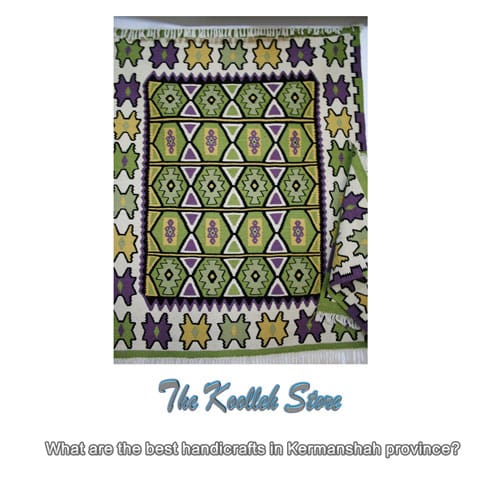What are the best handicrafts in Kermanshah province?

kilim weaving
kilim weaving is one of the home handicrafts that is common in most parts of Kermanshah province. Most kilim weaving workshops in the houses of Hersin villagers, as the main center of kilim production in the province, have a special reputation. kilim weaving is one of the home handicrafts that is common in most parts of Kermanshah province. The presence of favorable pastures for raising livestock that provide the necessary kilim fibers is a reason for the prevalence of kilim weaving in these areas. Military spring motifs, and the combined motifs of sparrow trees and nests, ducks, snakes, dolls, scissors, horizontal, vertical lines, the role of striped spools, cat claws, melon slices, overgrown flowers, cashmere flowers and needles There are designs that can be seen in the province’s kilims, especially Hersin. Hersin’s kilims also show signs of the intertwining of civilization and cultures. Other areas where kilim is woven include Javanroud, Gilan Gharb and Rijab.
Wave weaving
Wave and in the local term woven and woven bed is woven from pure wool, the production of which mostly has the aspect of meeting local needs and familiar customers. Wave and in the local term woven bed and woven bed is woven from pure wool. Its production is mostly about meeting local needs and familiar customers. Wave weaving is one of the home arts that is still popular in the Oramanat region. Rainbow waves have a special reputation in Oramanat and Javanrood. In Javanrood, this industry has found a workshop, so that in these workshops, in July, they are still weaving behind the machines. Today, the wave is still used, so that in some cases it is used instead of blankets or bedspreads or upholstery, underlays, curtains, and even large pillows. Janmaz or Sajadeh is another wave weaving workshop. The incision is small and about 60 x 110 cm. The coloring and embossing of Janmaz is influenced by the spiritual aspect of its use, and unlike the wave, which has happy colors. Its color combination is black, white and brown. The most important wave weave designs are Kashkoli, Chahar Khaneh, Siah Se Sefid, Takht Torkh, Barmali and Chess. Wave weavers are also able to weave and offer any order from the customers.
Financial felt
Financial felt is one of the traditional applied arts of Kermanshah nomadic region that has existed in this province for a long time and has a long history. Handicraft felt is one of the traditional applied arts of Kermanshah nomadic region that has existed in this province for a long time. It has a long history of hand weaving. In the past, all kinds of woolen coatings and undergarments, even horse saddles, were made of felt. Currently, the consumption of its cover is such as felt hat, vest and vulva, and how beautiful are the colorful patterns of these felt pieces In the black floor, tents and shepherds show off. The use of felt is more common among nomads, especially those who are migrating. The underlying felt of the area is usually in two colors, black and white, in white on the black background. Of course, the colors green, red, orange, and purple add to the white to decorate it. Common roles on felt in different parts of Kermanshah are: sword and pistol, rainbow, bergamot, ax, tree and sparrow, ram’s head, lotus, mountain goat, chicken, flower, step, royal collar.
What a weaver
Chegh or Cheikh is a mat with a width of approximately 150 cm, on which different roles are created by colorful woolen threads. Chegh is used to protect the tents around the black tents and is sometimes used to divide the nomadic tents into several separate sections.
Mortar
Weeding is one of the handicrafts of Kermanshah province, which has a long history. Giove is also called the local Clash. Mountainous areas, and impassable and rocky passages have made the use of mercury as a soft, light, comfortable and durable footwear in Kermanshah common. The centers for making mercury are Paveh Hersin and Kermanshah. The wedge consists of two floors, the top and the bottom. The sole is usually made of rubber and leather, but it is made of yarn. Prior to the advent of the rubber industry, weavers in Kermanshah used to make their undergarments from buffalo skin and weave the process from yarn or silk, which was used by most nobles. With the advent of the rubber industry, it was used for workers and farmers under rubber. The second type of Clash is known as the Orami Clash, which is the area’s weavers known as the “Second.” Finally, the master under the wedge is connected from the old cloth that is pounded and with the dry intestine of the animals that are said to be dark, which is completely different from the weeds of Kermanshah and Hersin in terms of form and design. The most important. Types of weaving products include foot tails, high heels, ivory wedges, closed backs, shoes, towels, beads, emperors, javelin, nets and real estate.
Metal tools
Currently, there are workshops in the city of Krand that are more or less engaged in the manufacture of metal tools and tools. Karandi artisans are well known for their tools and equipment for hunting and hunting, knives, knives, sugar grinders, saddlery, locks and keys. Unfortunately, this industry is currently being destroyed due to the lack of attention to the working metal of Karand, and in addition to a few traditional workshops, they have generally disappeared and are declining. In addition to Krand, there are several blacksmith workshops in Kermanshah that make up most of the cultivation tools.
Engraving
The art of engraving in this province has once had a special effect and great calligraphers have been working in this region. Professional engravers of Kermanshah, Master Ali Akbar Ein Al-Qadaei, who has revived this art by teaching engraving to the youth of Kermanshah. Inspired by the historical monuments of the Achaemenid and Sassanid periods and the nature of the region, the calligraphers of Kermanshah have finally created the elegance and beauty of great works of art that are world famous.
Curtain weaving – Jajim weaving
Curtain weaving is also one of the handmade industries of Kermanshah. Jajim Bafi is another handicraft in Kermanshah that has long been popular among rural and nomadic families.
Curtain weaving is also one of the handmade industries of Kermanshah and there are still several textiles in Kermanshah that weave cotton curtains in different sizes. The same machine used in weaving is used to weave the curtain. Jajim weaving is another handicraft in Kermanshah that has long been popular among rural and nomadic families. Jajim is used as a warm cover. Even among some families, the village of Jajim is given as a gift as a bright eye and a dowry for young people, and as a valuable memory that remains in families for many years, the raw materials of Jajim are wool and its texture is similar to kilim The difference is that the jajim is woven in four boards and connected and sewn together after weaving. In the Oraman and Thalas regions, women weave jajim with various patterns and high quality materials, which is unique in its kind.
Carpet weaving
Carpet weaving has existed among the villagers of Kermanshah for many years as a side activity with self-consumption value and with local and indigenous motifs. Well-known local roles, the name of certain minimalist weaving villages have existed as a side activity with self-consumption value and with local and indigenous motifs among the villagers of Kermanshah for many years. Well-known local roles have the names of certain villages, including the roles of Hosseinabad, Akbar Abadi, and Kiyani. , Dinur and Biston, carpet weaving is permanent. Among the nomads of the western region of Kermanshah, especially Salas Babajani, although carpet weaving is not the main handicraft industry, carpet weaving is also woven along with kilim weaving and other handicrafts. In Kermanshah’s carpet weaving culture, the word “flower” is used to mean a role, just as in Akbarabad flower, bergamot flower, the meaning of the flower is the carpet flower map. Well-known roles in carpet weaving in this region include Dargol, Bazobandi, Samavari, Abdollahi, Akbar Abadi, Kiyani and Hosseinabadi, each of which includes a collection of sub-roles. Have.






